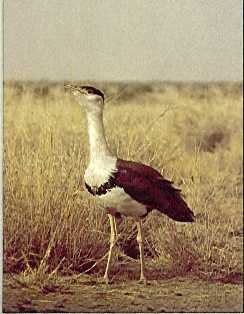
Travel India The Great Indian Bustard
extinction
In fact, it is the most endangered member of the bustard family in the world;
and has disappeared from almost 90 per cent of its former habitat.
The total population of the Great Indian Bustard is estimated to be around 700.
You can see the Great Indian Bustard in the Desert National Park (Rajasthan) and in the Lala-Parjau Sanctuary in western Kutch (Gujarat).
Nanaj Bird Sanctuary (18 km from Sholapur)
The Nanaj Bird Sanctuary covering an area of 8,500 sq. kms. in Sholapur and Kolhapur Districts of Western Maharashtra was set up in 1975.
At that time, there were about 100 Great Indian Bustards.The number have dwindled down and only 34 Bustards remain in the Nanaj Bird Sanctuary today,
The State Government has taken a decision to cut down the Sanctuary to a shocking 300 sq. kms even though an expert committee appointed by the Government under the directions of the Supreme Court of India suggested a minimum of 1,190 sq. kms. to save the Bustards from extinction.The reason for this political decision is that land within a sanctuary cannot be sold or purchased.
Therefore, there is always a lot or pressure from various quarters to reduce the area.
Description
The male is about 122 cm (48 in) in length. Its weight is 18–32 lb (8–14.5 kg).
The female is shorter and lighter – about 92 cm (36 in) in length. Its weight is 7.8–15 lb (3.5–6.75 kg).
The sexes are similar in appearance although the male is deep sandy buff coloured. The crown of the head is black and crested.
The female is smaller than the male. Its head and neck are not pure white and the breast band is either rudimentary or absent.
The male is polygamous.
The Bustard breeds during March to September during which time the inflated fluffy white feathers of the male are inflated and displayed.
The male also raises the tail and folds it on its back.
The neck is folded and the male periodically produces a resonant, deep booming call. The female lays a single egg once a year and incubates it for about 27 days.
Nests are situated in open ground
Males take no part in incubation or care of the developing young.The eggs are at risk of destruction from other animals.
The fledglings remain with their mother till the following breeding season.
Habitat
The Bustard prefers dry, short grasslands, and open country, tall grass interspersed with cultivation where the vegetation is below its eye level (less than one metre high).
It avoids dense grasslands that hamper its movement.
It avoids irrigated areas.
It is omnivorous and feeds on seeds of grasses, small shrubs, insects, rats, grams, groundnuts, millets etc.
Reasons for the steady reducing population
The main reasons for the seriously fast declining population are poaching and the reduction of habitat due to cultivation and farming.
Present Status
According to the 2008 IUCN Red List Category (as evaluated by Bird Life International – the official Red List Authority for birds for IUCN), the bird has been classified as: Endangered.
But something more drastic than mere paper resolutions are necessary to save the magnificent bird from extinction.


has indian goverment steps to save bustard after the letter by ICUN
I want you to collect some donations from citizens and do something to preserve bustard
Excellent site. It was pleasant to me.
I want to say – thank you for this!
Great site. Good info
??????????????? – ???????????????!
Excellent site. It was pleasant to me.
……………………Great site………………………….
viagra
Great site. Good info
I want to say – thank you for this!
Pingback:partycasino bonus poam
If you have to do it, you might as well do it right
It is the coolest site,keep so!
xanax
Incredible site!
tramadol
Pingback:everest poker fxww
I am Very thank full the owner of this blog. Becouse of this blog is very imformative for me.. And I ask u some thiing You make more this type blog where we can get more knowledge. and any one tell me how can I find this type blog. http://www.penisenlargementz.com
Pingback:אדריכלות מסחרית nkdm
i love to save bustards